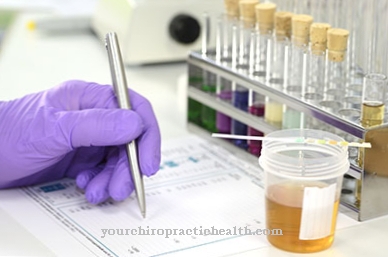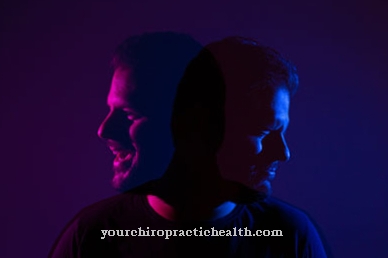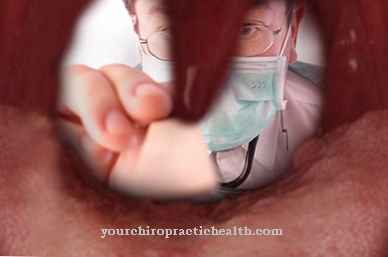Of the Heart attack, Heart attack or Myocardial infarction is often a life threatening and acute disease of the heart. This leads to the death (infarction) of heart tissue or myocardium (myocardium). The subsequent circulatory disturbance (ischemia) leads to the well-known heart attack.
What is a heart attack?

A heart attack is a disease of the heart that is life-threatening for humans. This is known colloquially as a heart attack or myocardial infarction. In human medicine, the abbreviation AMI (so-called acute myocardial infarction) is used for heart attacks. But what exactly is a heart attack? Part of the heart muscle (known as the myocardium) dies when one of the three coronary arteries is blocked.
This happens because of a circulatory disorder that occurs regularly over a period of more than 20 minutes. Most of the time, this happens through a blood clot that blocks one of the coronary arteries during a heart attack. The blood can no longer circulate there. The result is an interruption in the supply of oxygen and nutrients to the heart. If it is not possible to reopen this lock of the heart muscle, the part of the heart muscle that was actually supposed to be supplied by this vessel dies.
causes
But what are the causes of a heart attack? Such a heart disease is becoming more and more common in industrialized countries. In relation to Germany, around 250,000 people suffer a heart attack every year. A full 50 percent of these newly-infected patients die within four weeks of suffering a heart attack.
Various risk factors favor a disease of the heart muscle: for example obesity, lack of exercise, but also the consumption of nicotine. Other age-independent factors can be: diabetes mellitus (diabetes), high blood pressure or a family history (especially heart disease in close blood relatives).
Another increasing risk factor is the stress level. Sudden stress and / or extreme stressful situations that cause blood pressure to fluctuate significantly can trigger a heart attack. Around 40 percent of all heart attacks are recorded in the morning (between 6 a.m. and 10 a.m.) and especially on Mondays.
Symptoms, ailments & signs
A heart attack is characterized by sudden pain behind the breastbone, which rapidly increases in intensity and lasts for a long time. The pain often radiates to the left arm (rarely also the right), shoulder, upper abdomen or lower jaw.
In addition, chest tightness, shortness of breath, often dizziness, loss of consciousness, nausea and vomiting occur. The patient is pale and sweaty, he suffers from extreme restlessness and even fear of death. The level of blood pressure does not allow any reliable conclusions to be drawn about a heart attack: it can drop due to the restricted heart activity, but it can also be increased as a result of the increased release of stress hormones.
In women, a heart attack is often less noticeable and is therefore often not recognized as such, or recognized too late in many cases. Chest pain occurs less often, mostly shortness of breath, a feeling of pressure in the chest area, nausea and vomiting are in the foreground. Those affected often complain of pain in the upper abdomen, which is often misinterpreted as stomach problems. A heart attack can also hide behind a fainting attack without any further symptoms.
In both sexes, long time before the heart attack, shortness of breath, chest pain and tightness in the chest can indicate an incipient circulatory disorder of the heart.
course

How do I know if a heart attack is occurring? The occurrence of a heart attack is usually expressed by chest pain of varying strength and quality, depending on how the sick person feels. The feeling of strong pressure behind the breastbone or a feeling of tightness (oppression) in the entire area of the chest are typical signs of a heart attack.
The pain felt usually also affects the left arm, shoulder, neck, upper abdomen or back. Usually this pain persists for more than 20 minutes.
Side effects of a heart attack are not infrequently sweating, nausea or even vomiting. The occurrence of dangerous cardiac arrhythmias in the so-called acute phase of a heart attack make even smaller heart attacks life-threatening.
In women in particular, there are other symptoms of a heart attack: shortness of breath, general weakness, upset stomach and physical exhaustion.
Complications
The heart attack leads to very serious and life-threatening symptoms and complications, which often lead to the death of the patient. As a rule, the life expectancy of the person affected is greatly reduced even after the treatment of the heart attack. The other symptoms depend heavily on how long after the infarction the treatment begins.
With early treatment, the risk of irreversible consequential damage is minimized. The affected person suffers from severe chest pain and feelings of anxiety during a heart attack. Sweats and panic attacks occur. It is not uncommon for those affected to vomit and lose consciousness. Serious injuries can result from a fall.
In the further course of the infarction, damage to the brain and tissue death throughout the body occur. As a result, regions in the brain can be irreversibly damaged and organs can die. The damage in the brain then leads to restrictions in thinking and acting of the patient and possibly to restricted mobility. Treatment is done with the help of medication or surgery. However, it is not uncommon for the patient to die from a heart attack if treatment cannot be initiated early enough.
When should you go to the doctor?
Since a heart attack is a medical emergency, an ambulance service must be alerted immediately if it occurs. The person concerned is in acute danger of death, which makes immediate action necessary. Without rapid and professional medical care, the patient will die within a short time.
Until the emergency doctor arrives, the instructions of the rescue service must be followed in order to ensure the patient's survival. In particular, adequate ventilation must be guaranteed so that the consequential damage is kept as low as possible. However, it is advisable to consult a doctor as soon as there is warning of a heart attack.
If the person concerned suffers from palpitations, high blood pressure or circulatory disorders over a longer period of time, these must be examined and checked in good time. If there is pain in the chest or pulling in the left upper arm, a medical evaluation of the symptoms should be carried out. If the person concerned feels unwell, complains of a general feeling of illness or persistent weakness, it is advisable to consult a doctor.
A check-up is recommended in the event of a drop in the usual level of performance, a noticeable decline in physical capabilities or the feeling of burnout. If you experience sleep disorders, concentration problems or attention disorders, you should consult a doctor. A feeling of pressure in the chest is considered unusual and should be investigated.
Doctors & therapists in your area
Treatment & Therapy

But even after a heart attack, various treatment options are available, all of which aim (should) be to relieve the damaged heart muscle, but also to avoid further expansion of the heart attack and restore blood circulation. Of course, the following treatment methods can also be combined with one another to increase the result:
1. Blood-thinning therapy (aspirin and heparin are often used for this).
2. Beta blockers, which directly relieve the heart muscle.
3. Medicines to lower blood pressure, pain relievers, sedatives.
4. The vessel closed by the myocardial infarction can be opened by so-called lysis therapy or by balloon dilatation with the help of a cardiac catheter examination.
Outlook & forecast
The prognosis of a heart attack is linked to the timing of medical care. In most cases, the patient needs immediate emergency and intensive care to ensure survival. The risk of a fatal outcome is very high with a heart attack. The death rate increases immensely with age. Patients over 75 years of age are three times more likely to die than the average adult.
In addition, a heart attack usually leads to lifelong impairments and health problems. In addition to symptoms of paralysis, functional disorders and psychological stress, it can lead to the loss of a job and severe restrictions on the accustomed lifestyle. The general way of life must be changed and adapted to the patient's circumstances.
Medical care in the first two hours after the heart attack is crucial for its further course. If the ventricular fibrillation can be stopped and the arrhythmia corrected, the patient has a good long-term prognosis.
If heart failure develops or if the coronary arteries are permanently impaired, the prognosis worsens. Within two years of a heart attack, approximately 5-10% of patients die of sudden cardiac death. With a healthy lifestyle, optimal nutrition and avoidance of stress, the outlook improves.
prevention
How can you reduce or prevent the risk of a heart attack? The risk of a heart attack can be reduced significantly with the help of the following points:
1. You should have your blood pressure measured regularly. Adults over the age of 40, in particular, should have their blood pressure checked at least once a year. Too high blood pressure puts a strain on the heart. Values below 130 to 80 are considered good.
2. One should eat healthy. A conscious and healthy diet reduces the risk of a heart attack. On saturated fatty acids, especially in animal products such as butter, cream, pork, etc. a. should be avoided as these increase the level of cholesterol in the blood.
3. You should do enough sport. In particular, light endurance sports such as Nordic walking, cycling or swimming reduce the risk of heart attacks.
4. If you are overweight, you should reduce this excess weight. Already 10 kilos too much have a negative effect on our health, both blood pressure and blood lipid levels increase.
5. You should give yourself a smoking ban. Just six cigarettes a day double the risk of a heart attack, so stay away from it!
6. You should also avoid stress as much as possible. Basically, the body can withstand stressful situations, but you shouldn't overdo it here, as these can lead to high blood pressure.
Aftercare
The most important thing after a heart attack is to avoid further attacks. The patient must be aware that the underlying disease that led to the heart attack is still present. The main cause is usually arteriosclerosis. However, this affects not only the heart, but the vessels of the entire body. Eliminating risk factors is therefore one of the most important goals in the follow-up care for a heart attack.
A fundamental change in lifestyle is usually necessary. The top priority here is that smoking may have to be given up. Smoking also causes a constriction of the already loaded vessels and is considered risk factor number 1. Sport and exercise ensure that the body has a better metabolic result.
Last but not least, a balanced and healthy diet is important after a heart attack. From a medical point of view, the blood values in particular should be monitored, especially the cholesterol values should be checked regularly. If high blood pressure has also been diagnosed, this should be adjusted accordingly with medication, otherwise further vascular damage can occur.
Diabetes checks should also be carried out by the attending physician. By excluding the risk factors, the risk of a new heart attack is minimized, but the patient must always be aware that the underlying disease continues and that the measures mentioned are consistently incorporated into his everyday life.
You can do that yourself
An acute heart attack is a life-threatening situation in which the emergency doctor must be called immediately. However, patients can help ensure that it does not get that far and consult a doctor at the first early warning signs.
A heart attack is almost always on the horizon. Those affected often have chest pain, which is described as oppressive, and feel strong pressure behind the sternum. A doctor should be consulted at the latest as soon as the pain begins to radiate into the left arm or shoulder. Women often experience slightly different symptoms. Chest pain is then accompanied by shortness of breath, upset stomach and a feeling of general exhaustion.
Heart attack is still a male disease, which is why many doctors underestimate the risk in women. Patients who observe the symptoms described should therefore explicitly point out the possibility of a heart attack. This is especially true if the person belongs to a risk group or other family members have already suffered a heart attack.
The risks that significantly increase the risk of a heart attack include an unhealthy lifestyle, in particular being overweight, insufficient physical activity, excessive consumption of animal products (meat, sausages, fatty cheese, butter, cream) and regular high alcohol and nicotine consumption . Avoiding these risk factors is the best self-help measure against heart attack. If you have high blood pressure, you should also have it checked regularly by a doctor.

.jpg)
.jpg)
























